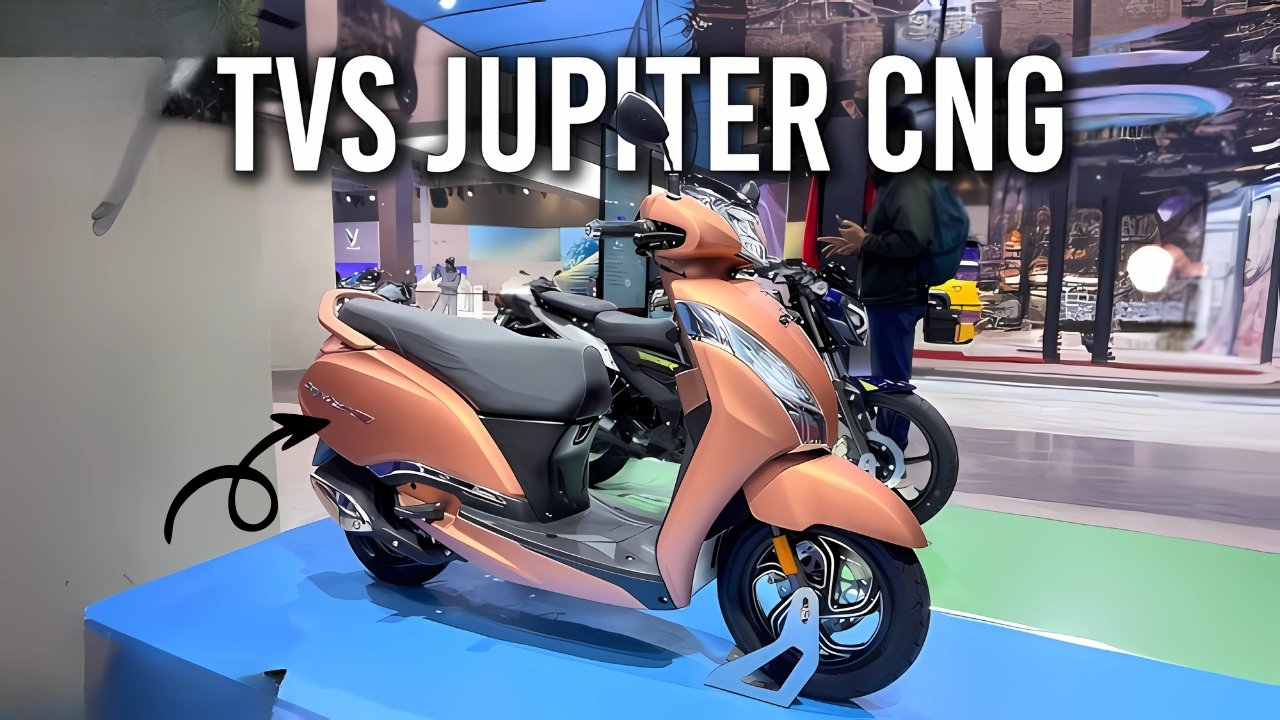TVS Jupiter CNG: TVS Motor Company shattered conventional boundaries in the two-wheeler segment by revealing the Jupiter CNG concept scooter at the Auto Expo 2025. This groundbreaking vehicle stands as the world’s first CNG-powered scooter, positioning TVS at the forefront of alternative fuel technology in the competitive Indian scooter market. Make a Content addressing how this innovative approach might reshape consumer expectations regarding fuel efficiency and environmental impact.
Revolutionary Dual-Fuel System Promises Extended Range
The Jupiter CNG incorporates an ingenious dual-fuel system that combines traditional petrol power with compressed natural gas capabilities. TVS engineers placed a 1.4kg CNG tank beneath the seat, sacrificing under-seat storage for significantly improved range. This thoughtful engineering solution maintains the scooter’s familiar silhouette while adding new functionality.
Unlike conventional single-fuel scooters, the Jupiter CNG features a dedicated 2-litre petrol tank mounted within the floorboard area, with its filler cap conveniently positioned in the front apron similar to the current Jupiter 125. This arrangement enables riders to switch between fuel sources seamlessly, addressing potential range anxiety associated with limited CNG infrastructure in certain regions.
TVS claims the scooter delivers approximately 84 kilometers per kilogram of CNG, with a combined total range reaching an impressive 226 kilometers between refueling stops. This extended range directly addresses daily commuter concerns regarding frequent refueling, particularly in congested urban environments where fuel station access often proves challenging during peak hours.
Familiar Performance with Environmental Benefits
The Jupiter CNG utilizes a modified version of TVS’s proven 124.8cc single-cylinder engine, carefully recalibrated to accommodate dual-fuel operation. This powerplant generates 7.1bhp at 6,000rpm alongside 9.4Nm of torque at 5,500rpm – figures that position it competitively within the 125cc segment despite its innovative fuel system.
The scooter achieves a claimed top speed of 80kmph, ensuring it maintains highway capability while delivering substantially reduced emissions compared to conventional petrol-only alternatives. CNG operation potentially reduces carbon monoxide emissions by up to 80% and nitrogen oxide by approximately 50% compared to equivalent petrol engines, addressing growing environmental concerns among increasingly eco-conscious consumers.
TVS retained familiar Jupiter design elements including comfortable ergonomics, intuitive controls, and reliable braking systems. This approach minimizes the learning curve for potential adopters transitioning from conventional scooters, focusing adaptation requirements solely on refueling procedures rather than overall vehicle operation.

Market Positioning and Economic Considerations
Industry analysts anticipate the production version reaching dealerships around October 2025, with expected pricing between ₹90,000 and ₹1,00,000. This positioning places it slightly above conventional 125cc offerings but significantly below electric alternatives with comparable range capabilities.
The economic proposition extends beyond purchase price through substantially reduced operating costs. CNG typically costs 40-50% less than petrol per kilometer, potentially saving frequent commuters thousands of rupees annually depending on usage patterns. This compelling operational economy could offset the initial premium over conventional models within two years for many riders.
Fleet operators and delivery services show particular interest in the platform given its potential for dramatic reductions in operating expenses. The predictable nature of commercial usage patterns aligns perfectly with planned refueling stops, minimizing potential challenges associated with CNG infrastructure limitations.
Huawei Nova 12s – Premium design smartphone launch with smart features
TVS Jupiter CNG Infrastructure Challenges and Market Readiness
The primary obstacle facing widespread CNG scooter adoption involves refueling infrastructure availability outside major metropolitan areas. While cities including Delhi, Mumbai, and Bangalore maintain robust CNG networks, tier-two cities and rural regions lack comparable coverage currently.
TVS acknowledges this limitation through the dual-fuel approach, ensuring riders maintain mobility regardless of CNG availability in particular regions. The company reportedly works alongside petroleum ministry officials and energy providers to accelerate CNG infrastructure development concurrently with vehicle production timelines.
Consumer education represents another significant challenge, particularly regarding safety perceptions surrounding pressurized gas storage within personal vehicles. TVS emphasizes the extensive testing protocols implemented during development, including crash testing, extreme temperature validation, and accelerated durability assessments specifically targeting the CNG system components.
The Jupiter CNG reflects TVS Motor Company’s commitment to sustainable mobility solutions without compromising practicality or affordability. Make a Content showcasing how this pioneering approach balances environmental responsibility with economic pragmatism, potentially establishing a new standard for accessible green transportation in the world’s largest two-wheeler market.